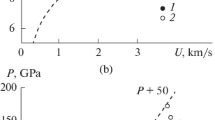Abstract
A numerical model for calculating superfast chemical reactions in mixtures under shock–wave loading is proposed. The effect of the impact velocity and chemical–transformation rate in a nonstoichiometric specimen of a low–porosity mixture of aluminum and sulfur is studied. Calculations were performed for impact velocities of 1000—2500 m/sec. The main characteristics of the process are given. It is found that flows occur when the unloading wave from the lateral surface of the specimen almost stops.
Similar content being viewed by others
REFERENCES
M. F. Gogulya, I. M. Voskoboinikov, A. Yu. Dolgoborodov, et al., “Sulfur-aluminum interaction behind shock waves,” Khim. Fiz., 11, No. 2, 244–247 (1992).
M. Koidzumi (ed.), Chemistry of Combustion Synthesis [Russian translation] Mir, Moscow (1998).
N. N. Thadhani, “Shock-induced chemical reactions and synthesis of materials,” Prog. Mater. Sci. 37, 117–226 (1993).
V. A. Gorel'skii, S. A. Zelepugin, S. S. Nabatov, and V. B. Nikulichev, “Experimental study and numerical modeling of the behavior of a titanium-silicon system subjected to shock-wave loading in a at recovery capsule,” Khim. Fiz., 18, No. 5 102–107 (1999).
L. Seaman, D. R. Curran, and D. A. Shokey, “Computational models for ductile and brittle fracture,” J. Appl. Phys. 47, No. 11, 4814–4826 (1976).
W. H. Gust, “High impact deformation of metal cylinders at elevated temperatures,” J. Appl. Phys., 53, No. 5, 3566–3575 (1982).
W. Herrmann, “Constitutive equations for compacting of porous materials,” in: Symp. on Applied Mechanics Aspects of Nuclear Effects in Materials, SCDC-71, Sandia Laboratories (1971).
L. A. Merzhievskii and V. M. Titov, “Longevity criterion for metals in the microsecond range,” Dokl. Akad. Nauk SSSR, 286, No. 1, 109–113 (1986).
G. R. Johnson, “High velocity impact calculations in three dimensions,” J. Appl. Mech., 44, No. 1, 95–100 (1977).
V. A. Gorel'skii, S. A. Zelepugin, and A. Yu. Smolin, “The effect of discretization in finite-element analysis of three-dimensional problems of high-velocity impact,” Vychisl. Mat. Mat. Fiz., 37, No. 6, 742–750 (1997).
Author information
Authors and Affiliations
Rights and permissions
About this article
Cite this article
Zelepugin, S.A., Nikulichev, V.B. Numerical Modeling of Sulfur—Aluminum Interaction under Shock–Wave Loading. Combustion, Explosion, and Shock Waves 36, 845–850 (2000). https://doi.org/10.1023/A:1002879428487
Issue Date:
DOI: https://doi.org/10.1023/A:1002879428487




